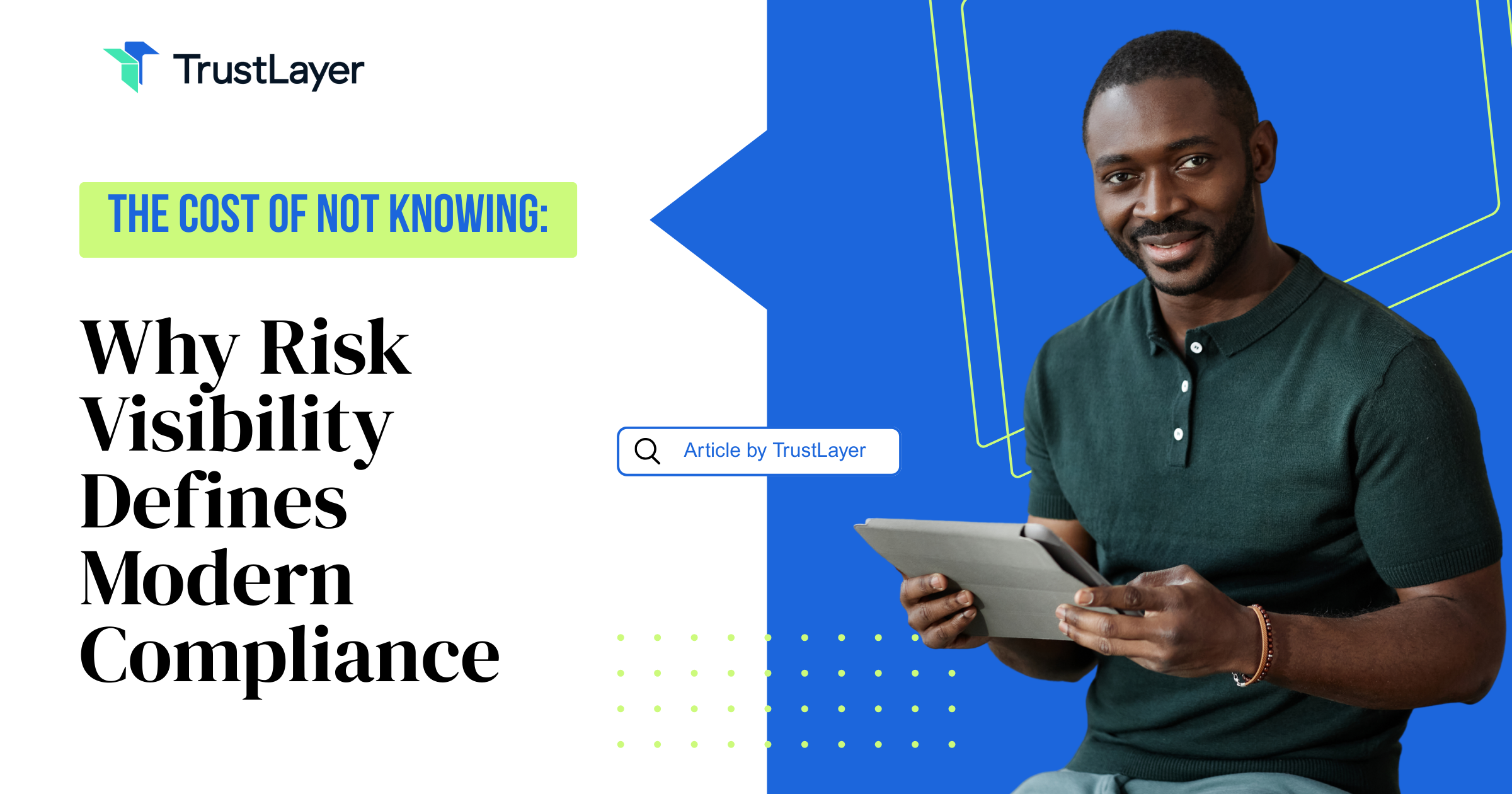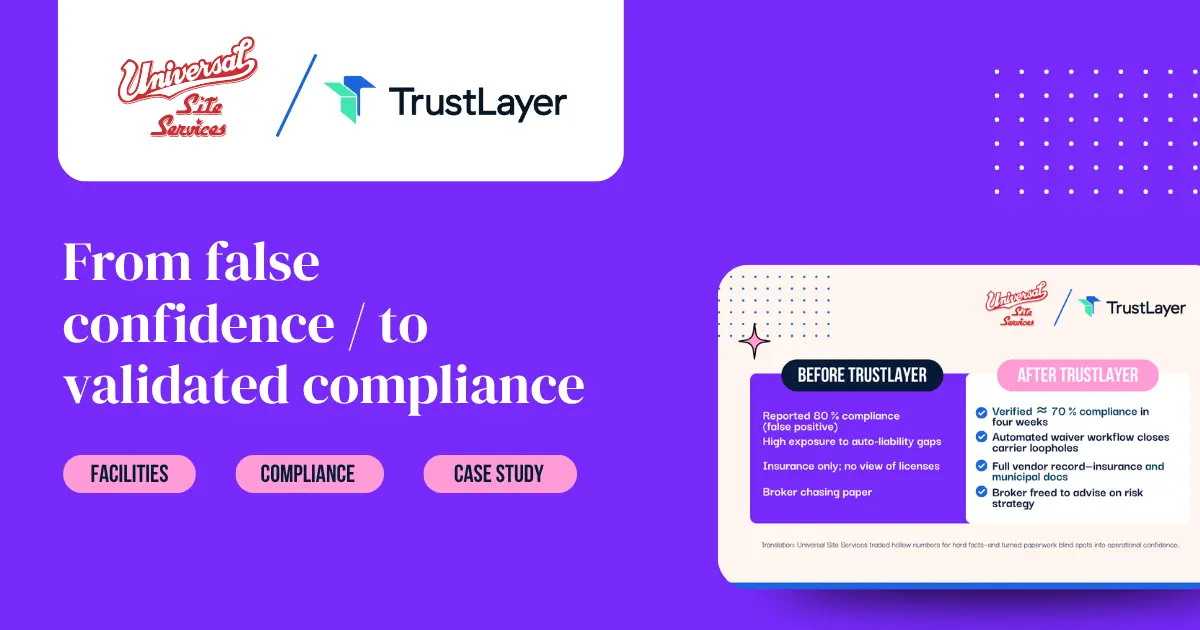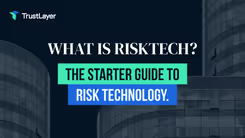The Cost of Not Knowing: Why Risk Visibility Defines Modern Compliance

Imagine a construction company that hires dozens of subcontractors every year. Each subcontractor provides a certificate of insurance (COI) to prove they’re covered. But what if some of those COIs are expired, fake, or don’t meet the project’s specific requirements? The company might think it’s protected, but in reality, it’s exposed to massive financial and legal risks. This is the hidden cost of not knowing.
Why Risk Visibility Isn’t Just a Buzzword
Risk visibility is more than a trendy phrase tossed around in boardrooms. It’s the precise, real-time understanding of where your vulnerabilities lie—whether that’s in your supply chain, your workforce, or your third-party vendors. Without it, compliance becomes a game of guesswork, and the stakes are high.
Consider the 2023 data breach at a major retail chain. The breach didn’t stem from a direct attack on the company’s systems but through a third-party vendor whose security posture was weak and poorly monitored. This vendor’s lack of compliance oversight cost the retailer millions in fines and lost customer trust. That’s risk visibility in action—or rather, the lack of it.
Risk Visibility Drives Proactive Compliance
When organizations have a clear view of their risk landscape, they can act before issues spiral out of control. Waiting for audits or regulatory inspections to reveal gaps is like waiting for a fire to start before installing smoke detectors. It’s reactive, costly, and often too late.
Proactive compliance means continuously monitoring certificates of insurance, licenses, and other critical documents. It means knowing which subcontractors have valid coverage and which don’t, without sifting through piles of paperwork or relying on manual processes. By leveraging technology, organizations can automate these checks, ensuring that they always have up-to-date information at their fingertips. This not only streamlines operations but also fosters a culture of accountability, where every stakeholder understands their role in maintaining compliance and mitigating risks.
Moreover, risk visibility allows companies to make informed decisions. For instance, if a business can identify potential risks in its supply chain, it can diversify its suppliers or invest in more robust cybersecurity measures. This strategic foresight not only protects the organization from potential threats but also enhances its reputation in the marketplace. Clients and partners are more likely to engage with companies that demonstrate a commitment to risk management and transparency, ultimately leading to stronger business relationships and increased competitiveness.
The Real Costs of Ignorance
Ignoring risk visibility doesn’t just put companies at regulatory risk; it hits the bottom line hard. According to a 2023 report from the Ponemon Institute, organizations that fail to maintain apparent risk oversight experience data breaches that cost an average of $5.2 million—nearly double the cost for those with mature risk management programs.
But financial penalties are just the tip of the iceberg. There’s reputational damage, operational disruptions, and the erosion of customer trust. For example, a multinational logistics company lost a lucrative government contract after failing to verify that its subcontractors maintained adequate insurance coverage. The fallout wasn’t just financial—it damaged relationships that took years to build. Additionally, the ripple effects of such incidents can extend beyond immediate financial losses, leading to increased scrutiny from regulators and stakeholders alike, which can stifle growth and innovation.
Hidden Risks in COIs and Vendor Compliance
Certificates of insurance are a cornerstone of vendor risk management, yet they’re often mishandled. Expired COIs, insufficient coverage limits, and outright fraudulent documents slip through the cracks when companies rely on manual tracking or outdated systems.
Without risk visibility, companies may unknowingly accept vendors who pose a serious financial risk. If a vendor causes damage or injury but lacks proper insurance, the hiring company may be held liable for any resulting damages. This scenario is more common than many realize and underscores why visibility into COIs is non-negotiable. Furthermore, the complexity of modern supply chains means that the risk is often compounded; a single vendor's failure can cascade through the entire network, affecting multiple stakeholders and leading to extensive liabilities. Companies must therefore invest in robust systems that not only track COIs but also provide real-time insights into vendor compliance and risk profiles, ensuring that they can make informed decisions that protect their interests and those of their customers.
How Technology Shapes Risk Visibility
Technology isn’t a silver bullet, but it’s a game-changer. Advanced solutions now enable organizations to automate the collection, verification, and monitoring of COIs and other compliance documents. This automation reduces human error, accelerates workflows, and provides real-time dashboards that instantly highlight gaps. With the integration of artificial intelligence and machine learning, these systems can also learn from past data, predicting potential compliance issues before they arise. This proactive approach not only saves time but also significantly mitigates risks associated with non-compliance.
For instance, companies using modern risk visibility platforms report a 40% reduction in compliance-related incidents within the first year. This isn’t just about ticking boxes-it’s about transforming compliance from a burdensome chore into a strategic advantage. By leveraging data analytics, organizations can identify trends and patterns in their compliance efforts, allowing them to make informed decisions that align with their business goals. The result is a more resilient organization that can adapt to changing regulations and market conditions with agility.
The Role of Licensed Insurance Professionals
While technology streamlines processes, the expertise of licensed insurance professionals remains invaluable. These experts interpret complex insurance policies, verify coverage adequacy, and provide nuanced insights that software alone can’t offer. Their ability to understand the intricacies of various insurance products enables them to tailor solutions that best fit an organization’s unique risk profile, ensuring that no critical coverage gaps exist.
TrustLayer, for example, employs licensed insurance professionals who work in conjunction with their technology to ensure that risk assessments are accurate and comprehensive. This combination of human expertise and automation creates a robust defense against compliance failures. Furthermore, these professionals play a crucial role in educating stakeholders about the importance of compliance and risk management, fostering a culture of awareness and responsibility throughout the organization. By bridging the gap between technology and human insight, they empower businesses to navigate the complex landscape of risk with confidence.
Building a Culture of Risk Awareness
Risk visibility isn’t just about tools and processes; it’s about mindset. Organizations that prioritize transparency and accountability at every level foster cultures where compliance is everyone’s responsibility. This cultural shift reduces blind spots and encourages proactive risk management. By embedding risk awareness into the organizational DNA, companies can create an environment where employees feel empowered to speak up about potential issues without fear of retribution, leading to a more resilient and agile organization.
Training programs, regular communication, and clear protocols empower employees and partners alike to identify and escalate risks early. When everyone understands the cost of not knowing, compliance becomes a shared mission rather than a checkbox exercise. Additionally, integrating risk awareness into everyday conversations and decision-making processes can further reinforce this culture. For instance, incorporating risk assessments into project planning meetings ensures that potential pitfalls are discussed and addressed before they escalate into larger problems.
Case Study: A Manufacturing Firm’s Turnaround
A mid-sized manufacturing company was struggling with frequent compliance issues related to vendor insurance. After adopting a risk visibility strategy that combined technology with expert review, the company reduced insurance-related incidents by 60% over a 18-month period. Beyond cost savings, they improved supplier relationships and gained a competitive edge in bidding for new contracts. The shift not only streamlined operations but also fostered a sense of trust and collaboration among stakeholders, as suppliers felt more secure in their partnerships, knowing that the company was committed to maintaining high standards of compliance.
Furthermore, the company implemented regular workshops and feedback sessions to refine its risk management processes continually. Employees were encouraged to share their experiences and insights, which led to the development of innovative solutions and best practices that were adopted across the organization. This iterative approach not only kept the risk management strategy dynamic and responsive but also reinforced the idea that risk awareness is an ongoing journey rather than a destination. As a result, the manufacturing firm not only navigated compliance challenges more effectively but also positioned itself as a leader in industry standards, attracting new business opportunities and enhancing its reputation in the marketplace.
Looking Ahead: The Future of Compliance and Risk Visibility
As regulations evolve and supply chains become increasingly complex, risk visibility will become even more crucial. Emerging technologies, such as AI and machine learning, promise to enhance predictive risk analytics, enabling companies to anticipate and mitigate risks before they materialize. These technologies can analyze vast amounts of data in real-time, identifying patterns and anomalies that might go unnoticed by human analysts. This capability not only streamlines the risk assessment process but also empowers organizations to make informed decisions swiftly, thereby reducing potential exposure to unforeseen threats.
However, technology alone won’t suffice. The human element—experienced insurance professionals, vigilant compliance teams, and engaged leadership—will remain essential. Together, they will define the next generation of compliance excellence. The integration of technology with human insight creates a robust framework for risk management, where data-driven decisions are complemented by the nuanced understanding that comes from years of industry experience. This synergy is crucial for navigating the complexities of modern regulatory environments and ensuring that compliance strategies are not only practical but also adaptable to rapid changes.
Why Waiting Isn’t an Option
Every day without clear risk visibility is a day companies gamble with their financial health and reputation. The cost of not knowing is no longer hypothetical; it’s a tangible threat that can derail even the most established organizations. Recent studies have shown that organizations lacking comprehensive risk visibility are significantly more likely to experience compliance breaches, resulting in substantial fines and damage to their brand image. In an age where information travels at lightning speed, a single misstep can lead to a public relations crisis that takes years to recover from.
Investing in risk visibility isn’t just about compliance—it’s about survival and growth in a landscape where uncertainty is the only constant. Companies that proactively enhance their risk visibility not only protect themselves from potential pitfalls but also position themselves as leaders in their industries. By fostering a culture of transparency and accountability, organizations can build trust with stakeholders, clients, and customers alike. This proactive approach not only safeguards against risks but also opens up new avenues for innovation and strategic partnerships, ultimately driving long-term success in an increasingly competitive marketplace.
Take the Next Step
Understanding the full scope of your risk exposure is the foundation of effective compliance. If you’re ready to move beyond guesswork and manual processes, consider exploring more insights from TrustLayer’s collection of articles on risk management and insurance compliance. These resources cover a range of topics, including the latest regulatory updates, industry best practices, and innovative technologies that can help streamline your compliance efforts. By staying informed, you can better anticipate potential risks and implement proactive measures that safeguard your organization.
For tailored guidance, book a consult with TrustLayer’s licensed insurance professionals. Their expertise can help you navigate the complexities of COI management and develop a compliance strategy that protects your business today and in the future. With a deep understanding of the nuances in different industries, TrustLayer's team can provide customized solutions that align with your specific operational needs. Whether you’re a small startup or a large enterprise, their insights can empower you to make informed decisions that enhance your risk management framework.
Moreover, TrustLayer offers a wealth of case studies showcasing how other businesses have successfully transformed their compliance processes. These real-world examples demonstrate the tangible benefits of adopting a proactive approach to risk management, showcasing improvements in efficiency, cost savings, and enhanced overall business resilience. By learning from the experiences of others, you can identify strategies that resonate with your own organizational goals and challenges.
In addition to consulting services, TrustLayer also hosts webinars and workshops that provide interactive learning opportunities. These sessions cover a range of topics, from the fundamentals of risk assessment to advanced compliance strategies, allowing participants to engage with experts and ask pressing questions. By participating in these events, you can enhance your knowledge base and connect with a community of professionals who share your commitment to effective risk management.
Don't let the hidden costs of uncertainty compromise your business's future. Embrace the forward-leaning approach of modern risk management with TrustLayer, the best-in-class COI tracker designed for today's risk managers. Say goodbye to the administrative burden of manual document verification and step into an era of automated, efficient, and reliable compliance processes. Join the hundreds of thousands of companies that have already transformed their risk management practices with TrustLayer. Schedule a time to speak with our team and discover how we can tailor a solution that propels your business forward, ensuring you're always informed and one step ahead of the risks.
















